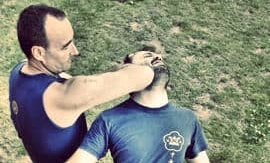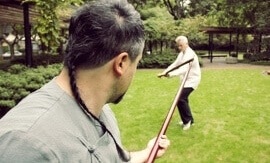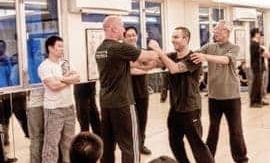
THE BIU TZE FORM REPRESENTS A BODY OF KNOWLEDGE IN WING TSUN THAT CAN BE AN EQUALISING FORCE FOR THOSE WHO LEARN IT PROPERLY. I FEEL VERY LUCKY TO HAVE LEARNED THE BIU TZE AND ITS APPLICATIONS NOT ONLY FROM THE SIFU LEUNG TING HIMSELF BUT ALSO FROM OTHER EXPERIENCED CHINESE MASTERS. HAVING SAID THAT, IT IS MY HOPE TO GIVE YOU SOME INSIGHT INTO THE CHINESE VERSION OF THE WING TSUN BIU TZE MATERIAL.
For most Chinese Wing Tsun practitioners, there is nothing mystical about this form at all. Many Westerners have ascribed almost supernatural power and dubious killing ability to it, but most Chinese don’t view it this way. Many have said that the Biu Tze provides solutions to emergency situations. Now unless you are a superhero, almost every fight is an emergency situation. Especially true if you are unable to knock out your opponent immediately. The Biu Tze certainly provides strategies to not only end the fight quickly but also to turn the tables when being pressed. In addition to helping us win quickly or win when we are overwhelmed, the Wing Tsun Biu Tze also trains special force to help increase striking power.
Every form in Wing Tsun helps to train the trainee in the basic body mechanics needed to perform the material for that level. The unique Saam Yiu Sau (Triple Swaying Hand) is a special exercise used to increase the force emitted by the wrist and forearm. This is performed with a stable arm, which is a bit different from the Sap Ji Sau (Cross Hand Waving Movement) of other Wing Chun styles. This allows us to not only generate Cheung Kiu Faat Lik (Long Bridge Force Extraction) but also to better apply throw locks and even a special Wu Sau lock on our opponent’s rear guarding hand.
The training of the elbow strikes adds a new dimension to the Biu Tze form’s physical training. That is the use of the spinal rotation in the thoracic spine to maximise the range of motion for the elbow strikes. In order for the elbow strikes to hit the centre, the spine must rotate. There is no other way for the elbow strikes to hit dead centre without this type of flexibility. This is related to the Yiu Lik (Waist Force) idea that begins in Chum Kiu and is expanded upon in Biu Tze. Waist force is emphasised in the elbow strike sequences, as well as in other sequences in the form of the Biu Tze.
In the Wing Tsun teaching programme, the first two Biu Tze Chi Sau sections emphasise the aggressive rapid resolution techniques. The last two Biu Tze Chi Sau sections emphasise the avoidance of a protracted battle with focus on special footwork and use of special techniques to interrupt the timing of an opponent.
The rapid resolution of a fight is, in fact, the ideal solution. The longer a fight goes unfinished, the greater the chance of injury to the fighter. For this reason, we try to finish the fight very quickly in hopes that we don’t need to exhaust our entire technical repertoire just to beat our opponent. To achieve this aim we have a number of very direct and aggressive techniques in the Biu Tze form at our disposal.
The Saat Geng Sau (Throat Killing Hand) and the Chaan Sau (Upper Spade Hand) are perhaps two of the most effective techniques in the set next to the three elbow strikes. The Saat Geng Sau, as the name implies, is a very direct chopping strike to the neck. The Chaan Sau is a unique striking method that hits the jawline in an upward fashion. This can not only knock out an opponent but can also cause damage to the cervical spine, teeth and jaw. These two techniques can be used interchangeably with the fist, making it an easy adjunct to previously learned movement patterns.
When a fighter is being helplessly driven back by a more aggressive opponent, the odds quickly get stacked against them. Being driven backwards is no easy situation to deal with and many times the simple Wing Tsun turn is just not enough to avoid the rush. Luckily, Wing Tsun has the footwork to keep the fighter braced even when moving backwards. These stepping patterns are known as Saam Gok Bo (Triangle Steps) or Chat Sing Bo (Seven Star Steps), which come from the Baat Jaam Do techniques.
With this footwork, techniques such as the Fan Biu Tze Sau (Chain-Thrusting Fingers) can be applied to cut through the opponent’s defence. The Wing Tsun fighter can simply counterattack once this is done or can apply other special techniques such as the lock throw and/or hooking punch to quickly turn the tide when getting pressed backwards.
The special strength training, rapid resolution techniques and emergency manoeuvres are just some of the skills that can be achieved with Wing Tsun’s Biu Tze material. In order to achieve these skills, a trainee must receive qualified instruction in the Biu Tze form, Biu Tze Chi Sau, Kuo Sau and sparring. With qualified instruction, the trainee is left to their own hard work and dedication in mastering the essence of this ingenious form.



















